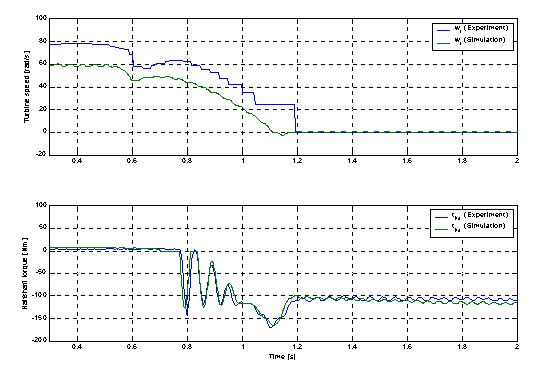Modeling of Automatic Transmissions
The conventional automotive automatic transmissions are equipped with planetary gear sets. The gear set usually consists of two planetary gears and the associated wet clutches and one-way clutches. A model for a typical four-speed automatic transmission gear set with five hydraulic clutches and two one-way clutches has been developed at the Ford Research Laboratory (FRL). The model includes the dominant gear set dynamics only, and thus has a simple structure convenient for different analysis and simulation studies. The clutch friction was modeled according to the well-known generalized Stribeck model, which was approximated by a steep straight line in the zero-speed region (so-called classical friction model).
In the friction modeling and simulation literature, it has been recognized that the use of such a friction model approximation can lead to physical and numerical problems, i.e. it can result in a slow simulation, and in some cases in inaccurate simulation results. This observation has been motivation for the development of the gear set model based on the Karnopp friction model for gear set clutches. A potential weakness of the Karnopp model is its complexity in applications on a complex multi-mass and multi-friction systems, and the automatic transmission is just such a system. Comparison of the proposed gear set model with the model based on the classical friction representation has pointed out to significant decrease of the simulation time (at least 3-7 times), as well as to more precise simulation.
A systematic analysis of the dynamic behavior of a power train with automatic transmission during the park/reverse engagement has also been conducted. First, a basic algebraic analysis based on simplified, linearized power train models for different park/reverse engagement phases has been carried out. The study is then extended with an analysis of the influence of transmission backlash, different gear set friction effects, engine block dynamics etc.. Based on the analysis results, several extensions of the present power train model are proposed, thus resulting in significant improvement in prediction of the experimentally observed power train behavior. The below figure illustrates the accuracy of model prediction for park/reverse engagements with fully pressed brake and released brake. Analysis and modeling of automatic transmission have been extended for the case of park/drive engagement.
As a part of the project, an analysis of torque converter dynamics has also been carried out. The analysis is based on linearized forms of standard second-order torque converter model (sometimes called static model) and more complex fourth-order model that includes the fluid and stator inertia effects. The analysis results in simplified linearized torque converter models that are convenient for control and estimation purposes. The emphasis is on analysis of torque converter capability of damping the power train vibrations.


Publications
-
ASME Journal of Dynamic Systems, Measurement, and Control, Vol. 139, No. 7, pp. 071004/1-7, 2017. -
Bond Graph Analysis and Optimal Control of the Hybrid Dual Clutch Transmission Shift Process
Proceedings of the Institution of Mechanical Engineers, Part K: Journal of Multi-Body Dynamics, Vol. 231, No 3. pp. pp. 480-492, 2017. -
Modeling and Analysis of Automatic Transmission Engagement Dynamics - Nonlinear Case including Validation
ASME Journal of Dynamic Systems, Measurement, and Control, Vol. 128, pp. 251-262, 2006. -
Modeling and Analysis of Automatic Transmission Engagement Dynamics - Linear Case
ASME Journal of Dynamic Systems, Measurement, and Control, Vol. 128, pp. 263-277, 2006. -
Recent Advances in Control-Oriented Modeling of Automotive Power Train Dynamics
IEEE/ASME Transactions on Mechatronics, Vol. 11, No. 5, pp. 513-523, 2006. -
A Bond Graph-Based Method of Automated Generation of Automatic Transmission Mathematical Model
SAE International Journal of Engines, Vol. 10, No. 3, 2017. -
Bond Graph Analysis of Automatic Transmission Shifts including Potential of Extra Clutch Control
SAE paper #2016-01-1146, SAE International Journal of Engines, Vol. 9, No. 3, pp. 1929-1945, 2016. -
Mathematical Analysis of Clutch Thermal Energy during Automatic Shifting Coupled with Input Torque Truncation
SAE paper #2020-01-0967, 2020 SAE World Congress, Detroit, MI, 2020. -
Bond Graph Analysis of Automatic Transmission Double-Transition Shift Dynamics
13th Int. Conference on Bond Graph Modeling (ICBGM), Summer Simulation Multi-Conference 2018, Bordeaux, France, 2018. -
Analysis of Influence of Inertia Coupling on Automatic Transmission Shift Dynamics
Powertrain Modelling and Control Conference (PMC 2018), Loughborough, UK, 2018. -
Bond Graph Analysis of Automatic Transmission Shifts including Potential of Extra Clutch Control
SAE paper #2016-01-1146, 2016 SAE World Congress, Detroit, MI, 2016. -
Bond Graph Analysis and Optimal Control of the Hybrid Dual Clutch Transmission Shift Process
Powertrain Modelling and Control Conference (PMC 2016), Loughborough, UK, 2016. -
Bond Graph Modeling of Automotive Transmissions and Drivelines
Proc. of 7th Vienna International Conference on Mathematical Modelling (MATHMOD), Vienna, Austria, 2012. -
A Power-split Hybrid Hydraulic Vehicle Transmission Modeling and Comparative Analysis
2010 SAE Commercial Vehicle Engineering Congress, Chicago, IL, 2010. -
Recent Advances in Control-Oriented Modeling of Automotive Power Train Dynamics
Proceedings of International IEEE Symposium on Industrial Electronics (ISIE 2005), Vol. 1, pp. 269-278, Dubrovnik, Croatia, 2005. -
Modeling of an Automotive Planetary Gear Set Based on Karnopp Model for Clutch Friction
Proceedings of 2003 ASME International Mechanical Engineering Congress and Exposition (IMECE 2003), Vol. 2, Washington, D.C., 2003. -
Analysis of Torque Converter Dynamics
2002 ASME International Mechanical Engineering Congress and Exposition (IMECE 2002) CD-ROM Proceedings, Vol. 2, New Orleans, LA, 2002. -
Optimal Shift Control of an Automatic Transmission with a Large Number of Gears [open access]
Doctoral thesis (in Croatian), Faculty of Mechanical Engineering and Naval Architecture, University of Zagreb, Croatia, 2019.